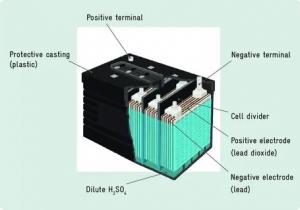Two Wheeler Lead Acid Batteries Market to Surpass USD 13.2 Billion by 2035 Amidst Demand for Affordable Energy Storage
Two-Wheeler Lead Acid Batteries Market grows steadily, driven by cost-effectiveness and rising two-wheeler demand in emerging economies.
Two-wheeler lead acid batteries offer significant benefits such as ruggedness, ease of maintenance, and well-established supply chains. These characteristics contribute to their enduring appeal, particularly in Asia-Pacific, where large-scale two-wheeler usage is driven by economic and infrastructural dynamics. According to market estimates, the Two-Wheeler Lead Acid Batteries Market will grow from USD 6,135.8 million in 2025 to USD 13,246.8 million by 2035, expanding at a compound annual growth rate (CAGR) of 8%. This growth reflects both the strong aftermarket replacement demand and OEM adoption of these batteries in budget and mid-range two-wheeler models.
Get Ahead with Our Report: Request Your Sample Now!
https://www.futuremarketinsights.com/reports/sample/rep-gb-11142
Key Takeaways for the Two Wheeler Lead Acid Batteries Market
The rising number of two-wheelers, especially in countries like India, Vietnam, and Indonesia, is fueling battery replacement cycles and boosting market demand. The dominance of lead acid batteries remains strong due to their mature technology and low total ownership cost. In addition, increased penetration of electric two-wheelers is also contributing to battery volume growth, particularly in low-speed electric scooters that often rely on lead acid configurations.
Aftermarket sales remain the largest revenue generator for lead acid battery manufacturers, supported by the short lifespan of batteries and the need for frequent replacement. Additionally, OEMs are focusing on budget two-wheelers in developing countries, which continue to rely on traditional lead acid batteries to keep costs competitive for end consumers.
Emerging Trends in the Global Market
One of the most notable trends is the growing push for sustainable battery solutions and enhanced recycling capabilities. Manufacturers are investing in environmentally friendly battery manufacturing and recovery processes to align with circular economy principles. Furthermore, sealed lead acid (SLA) battery variants are gaining preference due to their spill-proof design and reduced maintenance requirements, especially in urban delivery scooters and ride-share fleets.
There is also an increasing interest in hybrid battery models, where lead acid batteries may be used in conjunction with lithium-ion systems to balance cost and performance. Technological improvements are enhancing the charge acceptance and cycle life of advanced lead acid batteries, improving their competitiveness in the face of rising lithium-ion alternatives.
Significant Developments in the Global Sector: Trends and Opportunities in the Market
The market is witnessing key developments such as vertical integration by battery manufacturers to control raw material sourcing and improve margins. Companies are setting up recycling facilities to reduce dependency on virgin lead and to improve their environmental footprint. Furthermore, digital battery monitoring systems are being adopted to track battery health and performance, thereby extending product life and customer satisfaction.
Opportunities are emerging in rural mobility programs, especially in Africa and Southeast Asia, where two-wheelers serve as the backbone of personal and commercial transport. Government subsidies and microfinance programs are also encouraging ownership of low-cost two-wheelers, indirectly supporting the demand for lead acid batteries.
Recent Developments in the Market
Recent initiatives include the expansion of production capacities by top players such as Exide Industries and GS Yuasa to meet rising domestic and international demand. Companies are also entering strategic partnerships with OEMs to secure long-term supply agreements. In India, government e-mobility initiatives are encouraging the use of electric two-wheelers with locally sourced batteries, spurring domestic battery manufacturing. Additionally, several startups and regional players are exploring smart lead acid batteries integrated with IoT sensors to enhance their monitoring and predictive maintenance capabilities.
Detailed Market Study: Full Report and Analysis
https://www.futuremarketinsights.com/reports/two-wheeler-lead-acid-batteries-market
Competition Outlook
The global two-wheeler lead acid batteries market is moderately consolidated with leading players holding a strong presence in both OEM and aftermarket channels. Companies are focusing on product reliability, distribution network expansion, and technological upgrades to maintain their competitive edge. Brand recognition, warranty policies, and pricing are key factors influencing buyer decisions in this market segment.
Major players dominating the market include Exide Industries Ltd., GS Yuasa Corporation, Amara Raja Batteries Ltd., Leoch International Technology Ltd., and Camel Group Co., Ltd. These companies have extensive distribution networks, strong R&D capabilities, and are actively investing in sustainability initiatives.
Key Segmentations
The market is segmented based on battery type, vehicle type, sales channel, and geography. In terms of battery type, the segmentation includes flooded lead acid and sealed lead acid (SLA) batteries, with the latter gaining momentum due to ease of use and low maintenance. Vehicle types include motorcycles, scooters, and electric two-wheelers. Among these, scooters are seeing faster battery replacement cycles due to frequent stop-start usage.
By sales channel, the market is bifurcated into OEM and aftermarket, with aftermarket accounting for a larger revenue share owing to recurring replacement needs. Geographically, Asia-Pacific dominates the market due to high two-wheeler penetration, followed by Latin America and Africa, where rising urbanization is increasing two-wheeler adoption. North America and Europe, while smaller in volume, are seeing gradual uptake of electric two-wheelers, creating niche opportunities for sealed lead acid batteries.
Electrification Components Industry Analysis Reports
Micro-mobility Charging Infrastructure Market Outlook 2025 to 2035
https://www.futuremarketinsights.com/reports/micro-mobility-charging-infrastructure-market
Battery Swapping Charging Infrastructure Market Outlook 2025 to 2035
https://www.futuremarketinsights.com/reports/battery-swapping-charging-infrastructure-market
Electric Vehicle Battery Housing Market Outlook from 2025 to 2035
https://www.futuremarketinsights.com/reports/electric-vehicle-battery-housing-market
Electric Vehicle Battery Market Outlook 2025 to 2035
https://www.futuremarketinsights.com/reports/electric-vehicle-battery-market
Automotive Lead Acid Battery Market Outlook from 2025 to 2035
https://www.futuremarketinsights.com/reports/automotive-lead-acid-battery-market
Ankush Nikam
Future Market Insights, Inc.
+91 90966 84197
email us here
Visit us on social media:
LinkedIn
Facebook
YouTube
X
Legal Disclaimer:
EIN Presswire provides this news content "as is" without warranty of any kind. We do not accept any responsibility or liability for the accuracy, content, images, videos, licenses, completeness, legality, or reliability of the information contained in this article. If you have any complaints or copyright issues related to this article, kindly contact the author above.
MRT to Showcase Fox Body Passion at Motor City Fox Fest 2025 in Dearborn, Michigan
Overhead Cranes Market to Reach $5.04 Bn, Globally, by 2027 at 4.9% CAGR: Allied Market Research
Cloud RAN Market Growing at 23.4% CAGR | Reach USD 85.9 Billion by 2031 Globally
Kalendarium
Więcej ważnych informacji
 Jedynka Newserii
Jedynka Newserii

 Jedynka Newserii
Jedynka Newserii

Prawo

Przedsiębiorcy chcą uproszczenia kontroli celno-skarbowych i podatkowych. Wskazują na potrzebę dialogu z kontrolerami
Poprawa relacji z fiskusem i urzędnikami przeprowadzającymi kontrole to jeden z najczęściej podnoszonych postulatów przez przedsiębiorców. W ramach deregulacji prowadzonej przez rząd domagają się oni większej współpracy i otwartości na wyjaśnienia ze strony organów podatkowych, jasnej interpretacji przepisów, partnerskiego traktowania oraz skrócenia procesu przedawnienia. Te zmiany mogłyby poprawić atmosferę i klimat dyskusji między przedsiębiorcami a rządem.
Bankowość
Banki zainteresowane projektami gospodarki obiegu zamkniętego. Chętniej finansują takie inwestycje

Rynek zrównoważonego finansowania rośnie. Banki stawiają na rozwój oferty zielonych instrumentów, które przedsiębiorcy i inne instytucje mogą przeznaczyć na sfinansowanie inwestycji z różnych obszarów ESG. Są wśród nich zarówno zielone obligacje, jak i kredyty połączone z realizacją konkretnych celów klimatycznych. Jednym z obszarów, które chcą finansować firmy w ramach ESG, jest gospodarka obiegu zamkniętego, czyli zamykanie obiegu produktów w myśl zasady reduce, reuse i recycle (ogranicz, użyj ponownie, przetwórz).
Handel
E-papierosy i aromatyzowane saszetki nikotynowe mogą zniknąć z rynku. Ministerstwo Zdrowia chce całkowitego zakazu ich sprzedaży

W wykazie prac legislacyjnych pojawiła się nowa propozycja Ministerstwa Zdrowia, która przewiduje zakaz wprowadzania do obrotu papierosów elektronicznych jednorazowego użytku – zarówno tych z nikotyną, jak i bez niej, oraz zakaz stosowania aromatów w woreczkach nikotynowych. Projekt trafił do konsultacji społecznych. To już kolejna regulacja sektora tytoniowego w ostatnich miesiącach. Przedstawiciele biznesu podkreślają, że to chaos regulacyjny, który wpływa na brak poczucia pewności prawnej i decyzje inwestycyjne.
Partner serwisu
Szkolenia

Akademia Newserii
Akademia Newserii to projekt, w ramach którego najlepsi polscy dziennikarze biznesowi, giełdowi oraz lifestylowi, a także szkoleniowcy z wieloletnim doświadczeniem dzielą się swoją wiedzą nt. pracy z mediami.









.gif)

 |
| |
| |
|